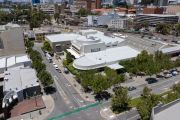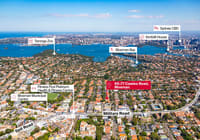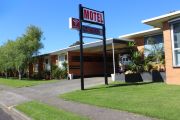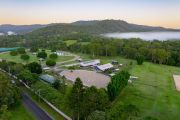
Co-working: inside the hottest trend sweeping the workplace
I’m sitting at a desk in one of Sydney’s currently most fashionable buildings, looking down over the harbour.
There’s a gentle hum of quiet conversation, the tapping of computer keys, the click of high heels on polished tiles, the fizz of a coffee machine in the distance and the murmur of discussion on phones from a screened section in the corner.
Welcome to the future of work: the shared office space, or co-working.
This whole floor on the 35th level of Barangaroo’s Tower One, at 2500 square metres, is the largest serviced office space in Australia being offered by the Sydney-based Servcorp, one of the top providers of serviced offices in the world. I’m in their major co-working zone, which can accommodate up to 40 people at hot desks, dedicated desks, high stools around a bench table or in any of their breakout areas.
From here, at athe desk that would normally cost about around $450 a month, it’s easy to see the attraction of the hottest trend sweeping the international workplace. “Ten years ago, we all thought working from home would be the real trendsetter,” says Liane Gorman, Servcorp general manager. “But that’s not necessarily the case.”
Studies have shown that not everyone wants to work from home, and for a variety of different reasons.
“But co-working – sharing office space – is now taking the world by storm,” Gorman says. “It provides an opportunity to mix with other people, you have the infrastructure of high-speed internet, IT, phones and a receptionist answering calls all provided, facilities like bookable meeting and conference rooms, and the flexibility of as much space or as little for however long you want it. It’s now becoming very mainstream and is a real disrupter in the market for professional office space.”
Their customers evidently agree. The space at Barangaroo, one of 25 Servcorp locations in Australia and 155 worldwide, has only been open for only six months and is already half full. The lure for many is the prestige of the address and the high-profile corporate neighbours.
The rapid rise in the popularity of co-working has taken many by surprise. Already In Melbourne there are already about around 170 co-working providers across 65,000 square metres of office space, with the biggest Hub Melbourne, The Commons and Team Square.
Kimberley Paterson, associate director research and consulting of commercial and residential property agents Knight Frank, Victoria, says the growth has been astounding.
“We’ve seen growth in Melbourne over the last three years of 960 per cent,” she says. “So year-on-year we’re seeing the trend becoming stronger and more widespread, and already accounting for nearly 1 per cent of total office space.
“In Sydney, the amount of co-working space has grown by 41 per cent per annum in the 10 years to October 2016, when there was 15,600 square metres. Contributing to strong growth in the Sydney CBD was the arrival of the world’s largest shared office space operator, the American-owned WeWork, with 3260 square metres in Martin Place. It’s coming into Melbourne later this year too and by the end of this year will have two sites in Melbourne and a further 4300-square-metre site in Sydney, in George Street.”
The $16 billion WeWork is even extending its office-sharing concept to apartment-sharing, with its WeLive spin-off offering shared space to live in. “I think we can definitely see that as something that could happen here in the future, too,” says Paterson. “I think they’ll probably roll that model out here as they have done with their office model.”
Globally the number of people co-working is predicted to reach 1.2 million by the end of the year, with 2017 with the number of co-working spaces anticipated to reach 14,000 co-working spaces worldwide, Paterson believes.
Enthusiasm shows little sign of waning. Sam Crowther, 21, founder of cyber-security start-up Kasada, leases co-working space for his eight employees at Work Inc’s Bay 9, a set of funky offices under the northern end of the Sydney Harbour Bridge in Lavender Bay. “We love the flexibility of co-working where we don’t have to take out a three-year lease for an office to get a half-decent deal,” says Crowther, who’s just completed a big equity-raising venture.
“We wanted somewhere that’s cool and unique and gives us the flexibility to grow.”
It’s pretty much the same for the owners of the space too. Work Inc founder Mark Davidson started out a year ago, renting 30 desks out. He’ll have 500 by the end of this year, and 1000 by this time next year. A fixed desk 24-7 is priced from $160 a week with a landline, internet, and security included.
“You don’t have the financial liability of a long lease, fit-out and bank guarantees all using up your capital that small businesses can’t afford,” he says. “At the same time, it’s much more than just putting in desks and computers. It’s about building a community and an entrepreneurial environment and getting everyone to grow together. It’s those kind of intangibles you don’t see that’s the value. It’s the new way that people work.
“This industry is the Uber of office space. Over the next five to 10 years, companies won’t rent office space and put their people together. They’ll have individual contracts with people and outsource creativity and infrastructure. It’s the exposure to different ways of thinking that fosters people’s creativity. You might even elect to be members of three different workspaces, say, in North Sydney, the CBD and Parramatta to mix with all sorts of people. It’s a very sophisticated offering these days; it’s not full of hipsters on bean bags.”
It also offers businesses the chance to “flex up or down as required”, says property management company The GPT Group’s head of co-working business Space & Co Daniel Stiffe. The business has with venues in Melbourne, Sydney and Brisbane. “A lot of corporates today require a greater degree of flexibility and need to be agile to make decisions quickly.
“We are very confident demand will continue to grow from both SMEs and larger corporates, with our business likely to double by the end of the year, and we’re working out plans to expand into the future.”
Property agents CBRE work both with landlords and tenants to curate work space to produce engaged staff and long-term profits for office owners. Nicole Fitzgerald, director workplace strategy, Pacific CBRE, says Australians are now leading the way in co-working. The United States, Britain and Asia tend to be much more conservative in how they use space, she believes.
“Here our clients are much more open to exploring different ways of working and working outside the primary workplace,” Fitzgerald says. “You can see that from our quick uptake of activity-based working and agility working. Australian businesses are quite good at stepping outside the status quo.
“When we asked what is the next frontier of service-delivery to customers of office buildings, the highest percentage – 28 per cent – mentioned shared workspace facilities and co-working space.”













